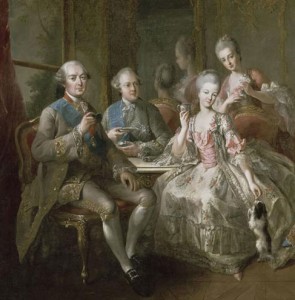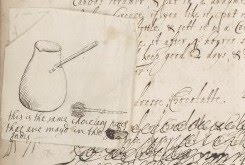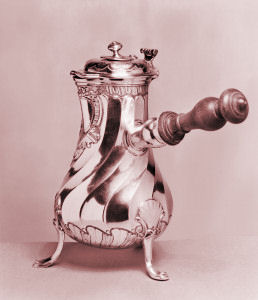Royal Wedding: 17th Century Court of France
It took a royal wedding to make chocolate a star. When the Spanish princess, Maria Theresa, came to the French court at Versailles to marry King Louis XIV in 1660, she brought her precious cacao beans with her, as well as her chocolate-loving ladies-in-waiting, and a crew of retainers just to make it. Hot chocolate was served at the wedding to the cream of European society. It eventually caught on at Versailles and Louis XIV came to love it. His personal recipe included an egg yolk to guarantee a rich thick concoction.
King Louis XIV in 1660, she brought her precious cacao beans with her, as well as her chocolate-loving ladies-in-waiting, and a crew of retainers just to make it. Hot chocolate was served at the wedding to the cream of European society. It eventually caught on at Versailles and Louis XIV came to love it. His personal recipe included an egg yolk to guarantee a rich thick concoction.
Medical Marvel
Much was made of the medicinal properties of chocolate by doctors and health experts on both sides of the Atlantic. It was thought of as a cure-all for everything from stomach upset to a fever and chills, and was described as an elixir of life. Chocolate was consumed for its health benefits instead of as a sweet treat. Some of chocolate’s rave reviews from physicians and medical experts of the 17th Century are:
“Chocolate, well known, is an invention so noble, that it should be the nourishment of the gods, rather than nectar or ambrosia.” – Joseph Bachot
“Good for the stomach if drunk in small quantities.” – Valverde Turices
“Chocolate gives comfort.” – Hurtado
“Chocolate is one of the most wholesome and precious drinks that have been discovered to this day.” – Stubbe
“Chocolate nourishes and preserves health entire, yet causes a pleasant and natural sleep and rest.” – Hughes
“Chocolate calms insomnia” – de Blégny
“Chocolate preserves health and prolongs the lives of old men.” – de Quelus
Served Hot
Early European Preparation and Equipment
Chocolate was served hot in liquid form. The 17th century saw the European additions of milk, sugar, and eggs as well as spices and flavorings such as vanilla, anise, rosewater, ground nuts, and ambergris. Europeans added their own touches to the preparation of the rich brew:
The metate stone slab was often imported from Mexico and used to grind the roasted, shelled cacao beans.
The molinillo was a Spanish wooden whisk or beater, used to make chocolate frothy and create foam, and is still in use today in Mexico and South America. In France it was known as the moussoir.
The mancerina was a special saucer that secured the chocolate cup to prevent spills.
The chocolatiere was a French chocolate pot that made it easier to prepare and pour the concoction.
Chocolate in Print in the 17th Century

There are good physiological reasons for chocolate’s popularity. It contains alkaloids such as theobromine and phenethylamine, which have been linked to increased serotonin levels in the brain: the Aztecs believed it to fight fatigue, doubtless for this reason. The feelgood effect of a chocolate hit is no illusion. Like most foreign substances that become a craze, however, it has been the subject of considerable suspicion over the years. We know that over-indulgence in our modern solid chocolate can lead to obesity, due to the sugar that is added in the manufacturing process. However, the core ingredient itself, the cocoa butter, has also been suspected (and indeed the theobromine in it does make it toxic to some animals, cats and dogs in particular).
 In our rare books collection, we hold a 1662 publication by Henry Stubbe, The Indian nectar, or, A discourse concerning chocolata, in which, as Stubbe says, the nature of the cacao-nut, and the other ingredients of that composition, is examined, and stated according to the judgment and experience of the Indians, and Spanish writers, who lived in the Indies, and others. Stubbe is particularly exercised by the fattiness of the nut, and also by its heat-producing qualities, discussing in detail whether it should be drunk hot or cold (“I found it [when cold] to offend my stomach”) and the correct time of day to take it:
In our rare books collection, we hold a 1662 publication by Henry Stubbe, The Indian nectar, or, A discourse concerning chocolata, in which, as Stubbe says, the nature of the cacao-nut, and the other ingredients of that composition, is examined, and stated according to the judgment and experience of the Indians, and Spanish writers, who lived in the Indies, and others. Stubbe is particularly exercised by the fattiness of the nut, and also by its heat-producing qualities, discussing in detail whether it should be drunk hot or cold (“I found it [when cold] to offend my stomach”) and the correct time of day to take it:
As to the time of taking it, it is held (by the Spaniards) the most fit time to take it in the Morning, and Supper being digested, and the Body fresh, and the Stomach empty to receive it.
A cup of chocolate is no light matter, it is clear, and due precautions must be taken: the Spanish, he notes, say that
after [they] have drunk Chocolata, they strictly prohibit all manner of Drink; for when Beer or Wine be drunk after it, there do frequently ensue very dangerous Diseases, and Symptomes.
Return to Top / Angelique Home Page / Home Page
Page refreshed : 23rd December 2016

